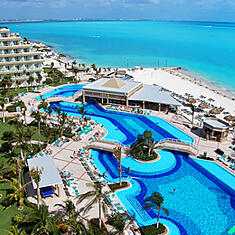 Spring break is a popular time of year, especially for those enduring snow and cold temperatures. Many families and college students like to visit countries such as Mexico, Aruba, the Dominican Republic, and Jamaica.
Spring break is a popular time of year, especially for those enduring snow and cold temperatures. Many families and college students like to visit countries such as Mexico, Aruba, the Dominican Republic, and Jamaica.
Below is a list of safety tips to remember when traveling.
1. Visiting ATMs.
If you need to withdraw cash from an ATM, travel with friends. Friends can scan the area to ensure nothing “fishy” is happening. Also, make sure to cover the keypad when you are entering your PIN.
2. Cash handling.
Carry a small amount of cash and keep the rest in your hotel room safe. If your cash is lost or stolen while out and about, you will still have some left to enjoy the rest of your trip.
3. Contact your credit card company.
Notifying your credit card company when you’ll be traveling is a good idea. If you don’t, they may put a hold on your account, preventing further card use. Also, talk to them about what your credit limit is. You can be arrested for exceeding your credit card limit, depending on the country.
4. Enroll in the U.S. Department of State’s Smart Traveler Enrollment Program (STEP).
By enrolling in this program, U.S. embassies and consulates can assist you if you are a victim of a crime, accident, or illness, or need assistance getting a new passport.
5. Keep your family or friends in the loop.
It is a good idea to leave copies of your itinerary and passport with family or friends so they can help you in an emergency.
6. Make sure to pack plenty of sunscreen and aloe lotion.
According to the American Academy of Dermatology, dermatologists recommend sunscreen with an SPF of at least 30. An SPF of 30 blocks 97% of the sun’s rays. Higher SPFs can block slightly more of the sun’s rays, but no sunscreen can block 100%. It is recommended that sunscreen be applied 15 minutes before sun exposure and every two hours or after swimming or sweating. If you have water-resistant or waterproof sunscreen, it can provide 40 – 80 minutes of protection while in the water. If you take precautions and still manage to get sunburn, click here for ways to treat it.
7. Drink plenty of water.
Alcohol, sun exposure, salt water, and caffeine can lead to dehydration. Make the most out of your vacation by alternating alcoholic drinks with water. If you experience dehydration (dizziness, weakness, confusion, muscle spasms, passing out, or dark urine), drink a large glass of ice water.
8. Don’t forget your hat, sunglasses, and a long-sleeved shirt.
While many people aim to return with a nice tan, it is vital to have these items along to protect you from overexposure to the sun.
9. Transportation.
Once you have booked your flight, research what your ground transportation options are. Talk to your hotel, or travel agent or review the airport’s website to find reputable ground transportation. The last thing you want to do is arrive at the airport without knowing how you will get to your hotel. If you plan on renting a car or moped during your stay, make sure you have proper insurance coverage and know the country’s driving laws.
Montego Bay – Sangster International Airport
Punta Cana International Airport
10. Ocean swimming.
Spending time on the beach and swimming in the ocean can be a relaxing and fun experience, especially as the tide comes in or out, or if there are some big waves. However, swimming with no lifeguard on duty can be dangerous. If you plan to swim in the ocean, have a friend or family member accompany you.
Also, knowing the warning flag system for water safety is essential.
• Red flags – This is the most severe flag and warns swimmers to stay out of the water due to strong undertows or riptides.
• Yellow flags – Use caution in the water; undertow and riptides are possible, but are not life-threatening.
• Green flags – Represent that it is safe to swim. However, always remember to use caution.
• Blue/purple flags – Use caution in the water as dangerous marine life may be present, including sharks and jellyfish.
For more detailed information on the country you plan on visiting on spring break or any other time during the year, visit http://www.travel.state.gov/
Do you have any suggestions or information you’d like to share? I’d love to hear from you. Please share them in the box below.





